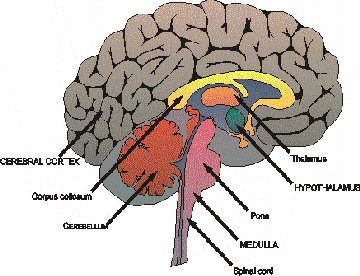- What is Meningioma of the Brain
- Statistics on Meningioma of the Brain
- Risk Factors for Meningioma of the Brain
- Progression of Meningioma of the Brain
- Symptoms of Meningioma of the Brain
- Clinical Examination of Meningioma of the Brain
- How is Meningioma of the Brain Diagnosed?
- Prognosis of Meningioma of the Brain
- How is Meningioma of the Brain Treated?
What is Meningioma of the Brain

The meninges are protective membranes which cover the brain. They are in 2 layers; 1 layer is applied closely to the brain and the other layer applied to the skull. The space between the 2 membranes is filled with cerebro-spinal fluid.
Statistics on Meningioma of the Brain
Meningiomas are relatively uncommon. More than 90% of meningiomas arise within the cranial fossa and occurs with highest incidence in patients aged 40 to 70 years with sex incidence being 3:1 female to males, except when the tumour occurs in children where the sex incidence is approximately equal. Meningiomas tend to increase in size during pregnancy.
Geographically, the tumour is found worldwide.
Risk Factors for Meningioma of the Brain
The only proven risk factor in the development of meningioma is exposure to ionising radiation – with tumours commonly developing following a 10 to 20 year lag time from exposure. Patients with neurofibromatosis type 2 (genetic defect on chromosome 22) are at an increased risk of developing meningioma..
Progression of Meningioma of the Brain
This type of tumour spreads by local invasion and erosion of surrounding bony structures through pressure effects. Meningiomas are very rarely malignant but occasionally tumours may show a tendency to recur.
The much rarer aggressive form of meningioma can invade adjacent bone structures and very rarely the brain.
How is Meningioma of the Brain Diagnosed?
General investigations may show erosion of bone on a plain skull xray.
Prognosis of Meningioma of the Brain
Benign meningiomas are associated with a very good survival prognosis with approximately 100% 5 year survival. Morbidity relates to the location of the tumour and the degree of neurological dysfunction at diagnosis. Malignant meningiomas have a poor prognosis with median survival of between one and three years even with treatment.
How is Meningioma of the Brain Treated?
The prime treatments of meningioma are surgical (this is usually curative) and radiotherapy.
Corticosteroids and antiepileptic drugs are given pre- and post-operatively.
Chemotherapy does not have a significant role.
Improvement in symptoms is an important measurement. Specific monitoring may be by serial imaging of the brain, e.g. with CT scans or MRI.
The symptoms that may require attention are headache which can be treated with standard analgesics. Headaches should be considered as a visceral pain.
Problems with function can be assisted greatly by Physiotherapists and Occupational Therapists.
A variety of equipment is available for the neurologically impaired to make life a little easier. Talk to your doctor about whether it is advisable to drive.
(Source: Dr Fran Boyle, Royal North Shore Hospital, NSW)
All content and media on the HealthEngine Blog is created and published online for informational purposes only. It is not intended to be a substitute for professional medical advice and should not be relied on as health or personal advice. Always seek the guidance of your doctor or other qualified health professional with any questions you may have regarding your health or a medical condition. Never disregard the advice of a medical professional, or delay in seeking it because of something you have read on this Website. If you think you may have a medical emergency, call your doctor, go to the nearest hospital emergency department, or call the emergency services immediately.







